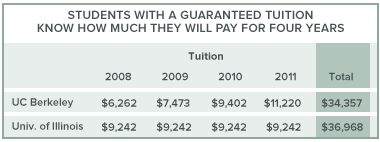This post is part of an occasional series examining how California can learn from policies in other states.
California’s public universities have a volatile tuition history. Stretches without increases are followed by sharp tuition hikes. The most recent increases in 2008—during the Great Recession—followed a pattern seen throughout the US: recessions generally cause states to allocate less money to their public universities, and the universities respond to the lost revenue by increasing tuition. Other states with similar tuition volatility have enacted policies to make tuition more predictable for students and their families.
Policy: Illinois Undergraduate Guaranteed Tuition Program
Since 2004, Illinois law has guaranteed that students who enroll in any of the state’s public universities pay the same tuition for four years. Any tuition increases that occur during those four years affect only the new class of freshmen. This allows students and their families to plan for the four years of college financially. But the policy covers only tuition—so students are still subject to yearly increases in other costs, such as room and board, other fees, and books. These additional expenses represent a large portion of the overall cost of college but are generally less volatile than tuition.
 How does guaranteed tuition in Illinois compare to year-to-year tuition in California? A University of Illinois Urbana–Champaign student starting in 2008 and finishing in four years knew in advance that tuition would be $9,242 for all four years, leaving the student with an overall bill of $36,968. For an incoming UC Berkeley student, tuition was a relatively low $6,262 in 2008, but that student did not know that tuition would increase 79% by the fourth year and would add up to more than $34,000.
How does guaranteed tuition in Illinois compare to year-to-year tuition in California? A University of Illinois Urbana–Champaign student starting in 2008 and finishing in four years knew in advance that tuition would be $9,242 for all four years, leaving the student with an overall bill of $36,968. For an incoming UC Berkeley student, tuition was a relatively low $6,262 in 2008, but that student did not know that tuition would increase 79% by the fourth year and would add up to more than $34,000.
Policy Impact
Institutions that guarantee the same tuition for four years risk bearing the cost of inflation and other external factors (such as a reductions in state funding). This risk could be handled in many ways, including dramatically increasing tuition for the newest class of students, accepting more out-of-state students (who pay much higher tuition), or setting tuition at a higher level than necessary in the first year of a student’s enrollment. In fact, a recent study suggests that colleges affected by the Illinois guaranteed tuition law have raised tuition for incoming students by 26% to 30%—or about $1,500. This has resulted in students paying about 7% more tuition on average than they would have paid without the policy. In short, these students may have traded affordability for predictability.
Lessons for California
A similar policy in California would make tuition predictable for students, but public universities would still be at the mercy of the state budget process, recessions, inflation, and other factors. The universities would have to plan very carefully or risk not having enough revenue. The current practice of setting tuition year to year may allow the state’s universities to be more flexible and responsive to changes in revenue. This practice makes tuition volatile, but it may offer students a cheaper degree.
Visit the PPIC Higher Education Center


